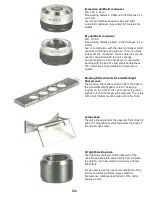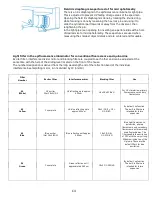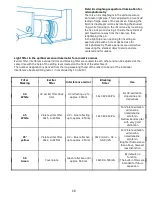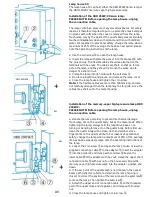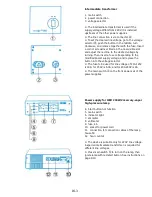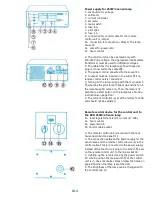
C13
Mixed illumination: epifluoretransmitted-
light polarization
A) Polarization with halogen lamp
⚪ Turn on halogen lamp with control transformer
⚪ Turn on optical relay (red dot)
⚪ Disengage Bertrand lens (pull out pin)
⚪ Rotate off the neutral density filters in the ocular body
(black dot not visible)
⚪ Install the analyzer
⚫ Set interference beamsplitter to 40
⚫ Rotate 10x objective into place. Stress-free objectives,
marked with P or IK, must be used for polarization
investigations
⚪ Remove exciter, neutral density, and color filters from
transmitted-light path (red dots)
⚫ Rotate upper condenser turret to brightfield. All
condensers described on page B2 are available in strain-
free
⚪ Turn lower condenser turret to empty opening (red dot)
⚫ Set condenser fine drive in the central position and raise
condenser with coarse feed up to the stop
⚪ Turn condenser auxiliary turret to red dot
⚪ Set the collector for transmitted-light halogen lamp to
red dot
⚪ Set the photo magnification changer to low (red dot, L)
⚪ Direct light path to the camera (red dot, CAM)
⚪ Direct 20% beam to the ocular tube (red dot, CAM/PRO)
⚪ Turn the phase ring knob to off (red dot)
⚪ Set magnification changer to 1x (red dot)
⚪ On the mirror house 2, set the rotary prism to
transmitted-light with halogen lamp
⚪ Set off color filters for contrast fluorescence (red dot)
⚪ On mirror house 2, set exciter filter to red dot
⚪ Set sliding mirror to halogen lamp (red dot)
⚪ Turn on automatic zoom lighting (red dot)
⚪ Focus on a specimen with coarse and fine adjustment
⚫ Center the field iris diaphragm in the middle of the field
of view with centering screws. Then open field iris
diaphragm just wider than the field of view
⚫ Close condenser iris diaphragm until the image appears
clear and full of contrast, but without diffraction halos
⚫ Swivel into place the polarizer on the bottom of the
condenser. The interference colors are visible when
observing a birefringent specimen.
⚫ To highlight the interference colors, close the condenser
iris more than the usual 2/3 open
⚪ For comparative observations with normal light, you can
swivel out the polarizer or the analyzer
Содержание Univar
Страница 1: ...Reichert Univar Manual...
Страница 2: ......
Страница 48: ...D6 blank no content...
Страница 58: ...E2 blank no content...


